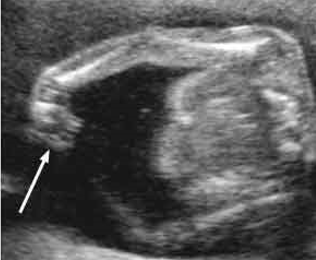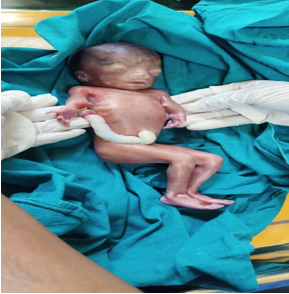- Visibility 177 Views
- Downloads 18 Downloads
- DOI 10.18231/j.sajhp.2021.004
-
CrossMark
- Citation
Medical termination of pregnancy with phocomelia
- Author Details:
-
Seep Sethi *
-
Meena Satia
-
Sri Ram
-
Prashant kashyap
Introduction
Phocomelia is a condition that involves malformations of human arms and legs. Although many factors can cause phocomelia, the prominent roots come from the use of the drug thalidomide and from genetic inheritance. Occurrence in an individual results in various abnormalities to the face, limbs, ears, nose, vessels and many other under developments. Although operations may improve some abnormalities, many are not surgically treatable due to the lack of nerves and other related structures. The term is from Ancient Greek φώκη phōkē, "seal (animal)" + -o- interfix + μέλος melos, "limb" + English suffix -ia). Phocomelia is an extremely rare congenital disorder involving malformation of the limbs (dysmelia). Étienne Geoffroy Saint-Hilaire coined the term in 1836[1]
Case Report
29 years old female, resident of kharghar Maharashtra, G3P1L1A1with previous LSCS I/V/O big size baby.? By date & by Scan 19 weeks with anomaly scan s/o phocomelia (condition that involves malformations of the arms and legs). Patient was ANC registered in Dr. DY Patil hospital, nerul, navi mumbai, Maharashtra. She had taken one dose of injection tetanus toxoid 0.5ml IM, she was on tab iron/calcium on regular bases. Patient did not give history of sore throat, cough, breathlessness, fever or covid-19 positive contact.
There was no significant history of any drug intake, exposure to any radiation/viral/bacterial/corona virus infection. There was no history of medical/surgical illness. She had menarche at age of 12 years with regular, moderate, painless cycles. No of pads/day: 2-3. There was no history of inter menstrual bleeding. She had one abortion at 2.5 months of period of gestation in 2015 D&C for the same was done in Dr. DY Patil hospital navi mumbai, Maharashtra. She had one live issue 4v yrs female, previous LSCS I/V/O big baby. The patient was vitally stable and with stable parameters.
On abdominal examination
Uterus size: 18-20 weeks in size, relaxed, clinically polyhydramnios was appreciated. PV: os was closed & uneffaced, No bleeding/discharge.


The patient had anomaly scan of 23/09/2020 s/o Phocomelia i.e. upper extremities appeared malformed. ([Figure 1]) Right arm- the humerus appears normal size corresponds to the gestational age. Radius absent. Thumb appears absent. Left arm- the humerus appears normal size corresponds to the gestational age. Radius & Ulna rudimentary/small hands less digits thumb absent.
The patient requested to terminate the pregnancy for which her written consent as well as her husband’s written consent were taken. During patient's hospital stay rapid antigen test was performed which was negative and other basic investigations were done as well all the above test were under normal limits. The patient was given Tab. Mifepristone 200mg per oral. On next morning patient was shifted to labour room for further management. On 25/09/2020 at 10:00am patient was given foley’s induction for which consent was taken from the patient and her husband explaining the procedure with risks and consequences. Patient’s vital parameters along with contractions were monitored half hourly. In the morning at 11:00am the patient started having contractions with stable vitals. At night 2:00am the patient was fully dilated and fully effaced cervix, patient was shifted to the delivery table with adequate maternal bearing down effort abortus was delivered at 2:15am weighing 250gms, Gender: unidentified in cephalic presentation. Inj. pitocin 10IU given IM. Hemostatsis achieved.
Malformed abort us noted. Right forearm: radius/ulna absent 3-4 digits, Left forearm: ulna/radius absent 3-4 digits. On PV: Passage of clots were present for which the patient was shifted to the OT and with adequate NBM, dilatation & curettage was performed under spinal anesthesia, placental bits was seen during D&C. Post D&C the patient was shifted to recovery with stable vitals and parameters. Inj. monocef(iv), inj.tramadol(iv), inj. amikacin(iv),inj. pan(iv), inj. emset (iv) was given. Uterus was well contracted, urine output was adequate. Patient was shifted to OBG ward for further observation. On day 1 post MTP/D&C the patient started on oral antibiotics includes: tab. monocef (200mg), tab. metro (400mg), tab pan-D (40mg), tab. Emset(4mg), tab, enzoflam. On PV: no active bleed.
The patient was stable and discharged on oral antibiotics on 26/09/2020.
Discussion
Phocomelia is a rare congenital defect defined by the absence of intermediate segments of the extremity. Children with phocomelia present with their hands or feet directly attached to the trunk. Phocomelia is famously a teratogenic side effect of the drug "thalidomide," a drug first marketed to treat anxiety and morning sickness. Despite claims that the drug was safe during pregnancy, it was removed from the market in the 1960s when clinicians noted an association with phocomelia. Forty percent of patients affected by the teratogenic effects of thalidomide died near the time of birth. These congenital disabilities had a profound social and political impact on drug regulation and proof of safety.[2], [3]
Etiology
While phocomelia is the most notable side effect of thalidomide, there have been several cases in the last 30 years of phocomelia associated with thalidomide use. However, today the cause of most cases is undetermined. Despite strict regulation worldwide, there have been several cases in the last 30 years of thalidomide attributed phocomelia. Underdeveloped countries and those endemic with leprosy where thalidomide occasionally remains in use, still report cases of defects caused by thalidomide exposures in pregnancy. Strict regulations in more developed countries have resulted in a dramatically decreased incidence of phocomelia within the general population.[4], [5]
Aside from the teratogenicity of thalidomide, researchers have hypothesized that phocomelia is associated with anomalous origins of the subclavian artery, resulting in a disrupted vascular supply to intermediate limb segments.[6], [7]
Epidemiology
The incidence and presentation of phocomelia were examined in 22,740,933 live births by Bermejo-Sanchez et al. in an effort to assess the prevalence of true phocomelia. Reports indicate that true phocomelia occurs in 0.62 live births per every 100,000 patients. Approximately half (53.2%) of the cases displayed isolated phocomelia, while 36.9% had additional major congenital abnormalities, and 9.9% of cases correlated with a clinical syndrome.
The data shows that 55.9% of cases only involve one limb, while 40.2% of cases only involved two limbs. Only four cases of 141 had involvement of all four limbs. When comparing single upper extremities deficiencies, the left side was more commonly affected (64.9%) than the right. When two limbs were involved, the upper limbs were involved 58.5% of the time compared to the lower limbs. The incidence of these findings was lower than what prior studies had reported, which is likely due to the care taken by this study, only to consider true phocomelia and not amelia or other limb truncation.[2], [8]
Pathophysiology
In extremity development, the apical ectodermal ridge forms at the most distal end of the limb bud. This apical ectodermal ridge through its interaction with the underlying progress zone mesoderm subsequently determines appropriate longitudinal growth of the extremity, as well as differentiation of distal and proximal structures of the limb bud. Cell death due to apoptosis from any cause such as vascular insufficiency or drug toxicity that interrupts this relationship between the apical ectodermal ridge and the progress zone can result in phocomelia.[9]
Differential diagnosis
Bermejo-Sanchez et al. report that 9.9% of cases of phocomelia are associated with different syndromes. They appear here in order of decreasing prevalence:[2]
Roberts syndrome: A rare autosomal recessive disorder caused by a mutation in the ESCO2 gene that manifests with severe limb malformations and craniofacial defects.[10]
Thrombocytopenia with radial aplasia (TAR): A rare autosomal recessive disorder related to the RBM8A gene that presents with thrombocytopenia and limb radial deficiency.[11]
Syndrome of severe limb defects, vertebral hyper-segmentation, and mirror polydactyly: An autosomal recessive disorder resulting in severe limb hypoplasia with polydactyly and hyper segmentation of the spine.[12]
Source of Funding
None.
Conflict of Interest
None.
References
- C Zimmer. Answers Begin to Emerge on How Thalidomide Caused Defects. 2010. [Google Scholar]
- E B Sánchez, L Cuevas, E Amar, S Bianca, F Bianchi, L D Botto. Phocomelia: A worldwide descriptive epidemiologic study in a large series of cases from the International Clearinghouse for Birth Defects Surveillance and Research, and overview of the literature. Am J Med Genet C Semin Med Genet 2011. [Google Scholar]
- J E Ridings. The thalidomide disaster, lessons from the past. Methods Mol Biol 2013. [Google Scholar] [Crossref]
- E E Castilla, P Ashton-Prolla, E Barreda-Mejia, D Brunoni, D P Cavalcanti, J Correa-Neto, J L Delgadillo, M G Dutra, T Felix, Giraldo A Juarez, N Lopez-Camelo, J S Nazer, J Orioli, I M Paz, J E Pessoto, M A Pina-Neto, J M Quadrelli, R Rittler, M Rueda, S Saltos, M Sánchez, O Schüler, L Thalidomide. . Teratology 1996. [Google Scholar] [Crossref]
- L S Faccini, R C Soares, A C De Sousa, C Maximino, E Luna, I V Schwartz. New cases of thalidomide embryopathy in Brazil. Birth Defects Res A Clin Mol Teratol 2007. [Google Scholar] [Crossref]
- R L V D Horst, M S Gotsman. Anomalous origin of the subclavian artery associated with phocomelia. S Afr Med J 1971. [Google Scholar]
- J N Bavinck, D D Weaver. Subclavian artery supply disruption sequence: hypothesis of a vascular etiology for Poland, Klippel-Feil, and Möbius anomalies. Am J Med Genet 1986. [Google Scholar] [Crossref]
- B Källén, T M Rahmani, J Winberg. Infants with congenital limb reduction registered in the Swedish Register of Congenital Malformations. Teratology 1984. [Google Scholar] [Crossref]
- J Knobloch, U Rüther. Shedding light on an old mystery: thalidomide suppresses survival pathways to induce limb defects. Cell Cycle 2008. [Google Scholar] [Crossref]
- S Ismail, M Essawi, N Sedky, H Hassan, A Fayez, N Helmy. Roberts Syndrome: Clinical and Cytogenetic Studies In 8 Egyptian Patients and Molecular Studies In 4 Patients With Genotype/Phenotype Correlation. Genet Couns 2016. [Google Scholar]
- M M Al-Qattan. The Pathogenesis of Radial Ray Deficiency in Thrombocytopenia-Absent Radius (TAR) Syndrome. J Coll Physicians Surg Pak 2016. [Google Scholar]
- M Urioste, I L Sánchez, M Blanco, E Burón, P Aparicio, M L M Frías. Severe congenital limb deficiencies, vertebral hypersegmentation, absent thymus and mirror polydactyly: a defect expression of a developmental control gene?. Hum Genet 1996. [Google Scholar] [Crossref]
